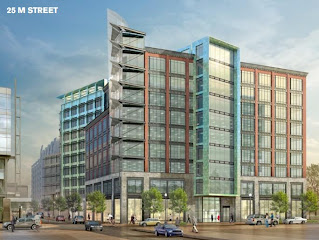"We're in the very, very early stages," Brown reiterated, it all (the programming and the design) "could change drastically." What is certain is that earlier this year the Corcoran Gallery sold the property and abandoned their plans to expand their College of Art after their partnership with Monument Realty fell apart. The buyers were Miami art collectors and museum founders Mera and Don Rubell, who forked over $6.5 million for the three-acre site, sporting a partnership with local firm Telesis, and grandiose plans to build a high-end hotel, a large residential component, and the first satellite location of their Miami museum.
Now, several months later, with some of the kinks in the original property disposition worked out, the development team is ready to hone in on their development plans. The schematic design process will begin in February, by which time the programming will be more solidified. The basic concept is certain: residential portion, art museum, retail (restaurants, museum shop, boutiques), and some sort of hospitality component, all totaling roughly 500,000 s.f.. What's left to be determined is whether the residential units will be condos or rentals, and exactly what shape the hotel-aspect takes on. The necessary market research is currently under way to aid in these sorts of decisions.
 As for massing and the architectural detailing of the buildings, those specifics will come into focus as the Zoning process unravels; Brown says the development team hopes to submit their PUD application in September of next year, with construction drawings firmed up and permits issued by late spring, early summer of 2012. With an expected two year construction process, that puts a delivery somewhere in mid-2014. Brown explained that the development plans as they stand are rather ambitious for the site, forcing designers to push the density of the project towards I Street, with buildings likely cantilevered over the restored Randall School structures. Brown thinks the auditorium space in the old school buildings would be ideal for a restaurant, with "beautiful vaulted ceilings, and a plinth along the sidewalk that has great potential for tables and chairs." A portion of the historic school will likely operate as the lobby to the art museum, which will open out the back into a middle courtyard. The developers will also reestablish Half Street through the site, bringing it half a block in its current direction, and turning it left to connect with First Street. This will allow proper traffic movement through the site, and have the back of the buildings serve as the main entrance.
As for massing and the architectural detailing of the buildings, those specifics will come into focus as the Zoning process unravels; Brown says the development team hopes to submit their PUD application in September of next year, with construction drawings firmed up and permits issued by late spring, early summer of 2012. With an expected two year construction process, that puts a delivery somewhere in mid-2014. Brown explained that the development plans as they stand are rather ambitious for the site, forcing designers to push the density of the project towards I Street, with buildings likely cantilevered over the restored Randall School structures. Brown thinks the auditorium space in the old school buildings would be ideal for a restaurant, with "beautiful vaulted ceilings, and a plinth along the sidewalk that has great potential for tables and chairs." A portion of the historic school will likely operate as the lobby to the art museum, which will open out the back into a middle courtyard. The developers will also reestablish Half Street through the site, bringing it half a block in its current direction, and turning it left to connect with First Street. This will allow proper traffic movement through the site, and have the back of the buildings serve as the main entrance.Given the historic nature and unique character of this project, an abundance of public meetings are sure to accompany all stages of this process. The development team, headed by Marilyn Melkonian President and founder of Telesis Corporation, has already held two preliminary meetings with ANC6D. Luckily, both the Rubels, who overhauled the Capitol Skyline Hotel across the street, and project architect Bing Thom, who designed the highly-regarded and well-received Arena Stage, have an established and positive relationship with the surrounding community. And they will surely need all the good-will they can muster if the final design looks anything like this early edition.
Washington D.C. Real Estate Development News















































